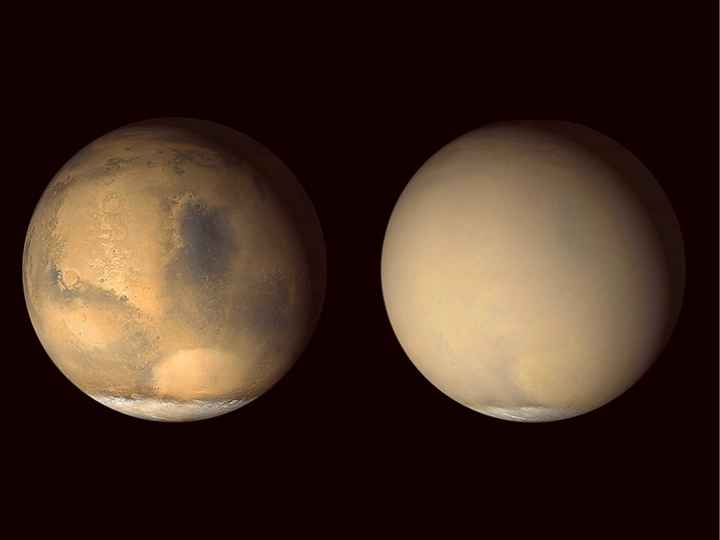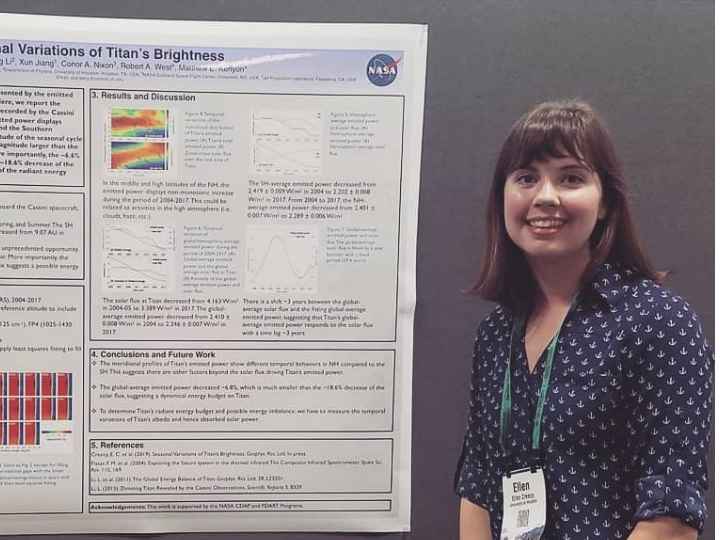

A seasonal imbalance in the amount of solar energy absorbed and released by the planet Mars is a likely cause of the dust storms that have long intrigued observers, a team of researchers reports.
Mars’ extreme imbalance in energy budget (a term referring to the measurement of solar energy a planet takes in from the sun then releases as heat) was documented by University of Houston researchers Liming Li, associate professor of physics; Xun Jiang, professor of atmospheric science; and Ellen Creecy, doctoral student and lead author of an article to be published this week in the Proceedings of the National Academy of Sciences (PNAS).
“One of our most interesting findings is that the energy excess – more energy being absorbed than emitted – could be one of the generating mechanisms of Mars’ dust storms. Understanding how this works on Mars might provide clues about the roles Earth’s energy budget takes in the development of severe storms, including hurricanes, on our own planet,” Creecy said.
A thin atmosphere and very elliptical orbit make Mars especially susceptible to wide temperature differences. It absorbs extreme amounts of solar heat when it swings closest to the sun in its perihelion seasons (spring and summer for Mars’ southern hemisphere), which is the same extreme part of the orbit when its dust storms appear. As its orbit takes Mars further away from the sun, less solar energy is absorbed by the planet. This same phenomenon happens on Earth, too, but the researchers found it to be especially extreme on Mars.
On Earth, energy imbalances can be measured according to season and year, and they play a critical role in our global warming and climate change. In a separate project, Creecy and her colleagues are examining if energy imbalance on Mars also exists on longer time scales, and if it does what the implications would be on the planet’s climate change.
“Mars is not a planet that has any kind of real energy storage mechanisms, like we have on Earth. Our large oceans, for example, help to equilibrate the climate system,” Creecy said.
Yet, Mars bears signs that oceans, lakes and rivers were once abundant. So what happened? The facts are unsettled as to why or when the planet dried into a hot, dusty globe with an abundance of iron oxide – rust, actually, whose tawny color inspired observers from centuries ago to call it the Red Planet.
“Mars had oceans and lakes in the past, but it later experienced global warming and climate change. Somehow, Mars lost its oceans and lakes. We know that climate change is happening on Earth now. So what do the lessons of Mars’ experience hold for the future of Earth?,” Li asked.
Creecy and her colleagues reached their conclusions by comparing four years of data (those are Martian years, roughly equivalent to eight Earth years) of Mars’ orbits and temperatures to conditions as documented by NASA missions.
For planetary enthusiasts, they note that much of the data can be accessed free from NASA’s Planetary Data Systems website, although some information is available only to researchers. They also collaborated with NASA scientists, including several who have been key members of past missions, including the Mars Global Surveyor and two rovers, Curiosity and Insight, which are still operating on site.
“If we open our eyes to a wide field, Earth is just one planet. With just one point, we never can see a complete picture. We have to look at all points, all planets, to get a complete picture of the evolution of our own Earth. There are many things we can learn from the other planets,” Li said. “By studying the history of Mars we gain a lot. What is climate change? What’s the future phase for our planet? What’s the evolution of Earth? So many things we can learn from other planets.”
Joining Creecy, Li and Jiang as co-authors of the article were Michael Smith of NASA Goddard Space Flight Center in Greenbelt, MD; David Kass and Armin Kleinböhl, both of the Jet Propulsion Laboratory at the California Institute of Technology; and Germán Martínez from the Lunar and Planetary Institute in Houston.